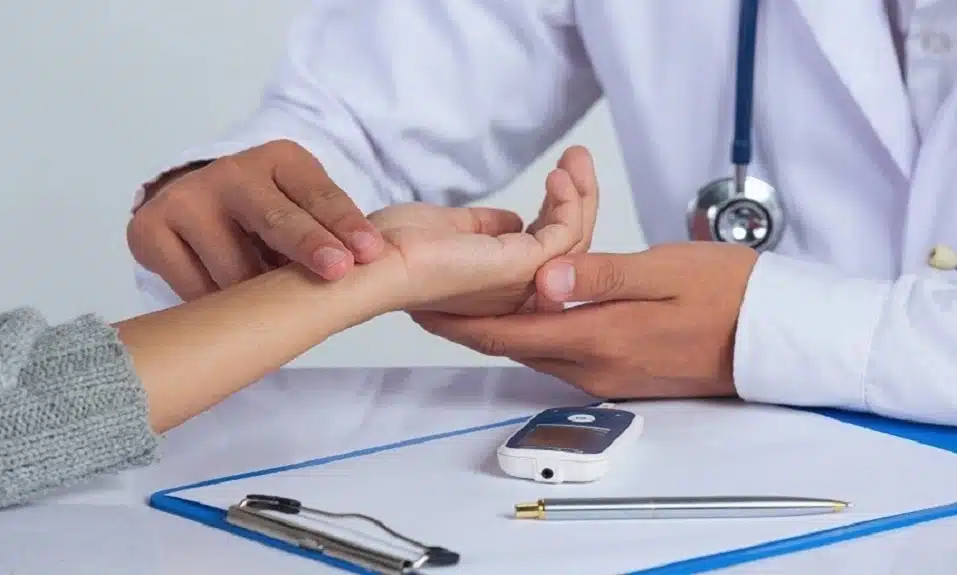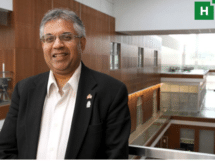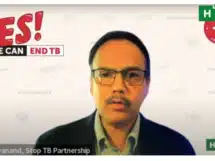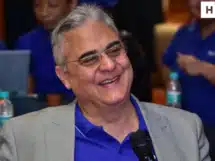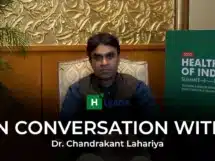From analysing clinical trials’ results, searching for missing data, debunking false claims, investigating conflicts of interest, reflecting on the health issue, exposing fake drugs, covering health and medicine can be a challenging topic. A chance investigative story led Serena Tinari to become one of the world’s leading investigative reporters with specialisation in health and medicine.
Serena is based in Bern, Switzerland and she is the co-founder of Re-Check, a non-profit organisation dedicated to investigating and mapping health affairs. She sat with Health Analytics Asia correspondent on the sidelines of the Global Investigative Journalism Conference held in Hamburg to talk about her work in investigative health journalism and how overdiagnosis is a threat to our health systems.
“The problem with this field [health] is complexity”, Serena told Health Analytics Asia. “Every actor of this field has an agenda.”
Excerpts from the interview:
Tell us about your interest in investigative health stories and the significance of shining the spotlight on issues related to health.
Health is an extremely important area for investigative journalism. What we know is that it is very popular because health issues touch everyone. And this is a field which lacked good journalism. Though, in the last couple of years that started to change. The work I try to do in my humble effort with Re-Check or alone is to improve this situation. Health and medicine are areas where there is a lot of money. The system is extremely complex with very strong influences and sometimes even for very good journalists it is difficult to get to the ground of it because most of us don’t have a background in science. What happened to me personally was kind of by chance.
Almost 20 years ago when I was a reporter at the Swiss television my editor asked me to go and interview the authorities about Vioxx, a drug that was famously removed from the market after an estimated 150,000 patients died because of its side effects. After the interview, I had the impression that regulatory authorities were under pressure and somehow hiding something. I went back to the newsroom and told my editor that we should investigate this field better. I was very lucky because the editor gave me time to learn. He told me “go out there and read books, read studies, talk to good people, do not interview anyone, study and then come back to me”. He gave me two months’ time and that is what I did. Most of the time, when you start investigating in this field like it often happens in investigative journalism, one story comes after the next. Throughout these years I learnt that it is possible to do good journalism on health and medicine. What is needed is, of course, to invest time and energy, because you need to learn and know quite a lot.
Before I ask you about Re-Check, I want to know despite being such an important subject, why are health stories under-reported?
One of the main reasons, in my opinion, is that you may easily feel overwhelmed and be afraid because you think “I am not knowledgeable enough”. In my experience whenever you get editors a good investigative story in this field, they are more than happy to publish it because it gets them a lot of audiences. My investigative documentaries for Swiss TV gained a lot of audiences, for instance. So it is not that there is no interest from editors’ and public side. I think there aren’t enough well trained and knowledgeable journalists who feel confident enough that they can do that. You think of course you have to study and make yourself knowledgeable. It has a lot to do with peoples’ fears as well. I mean you can do a story with hype and copy-paste journalism, but you are not doing a good service to the public. You should convey evidence, hard evidence. You have to free the table of influences that in this field are very strong. The problem with this area is complexity. Every actor in this field has an agenda.
Do you have in mind a comparison between how health is covered in Europe and how it is covered in Asia? Have you worked anywhere in Asia where you have seen a different kind of canvas?
No, I don’t think so. I have not. I am not experienced and can’t speak about that. I would be happy to know more.
Tell us about Re-Check? How did it start?
Ten years back, by chance, I came across a freelancer in Switzerland with a very similar background. Catherine Riva was also doing similar kind of investigations as I was doing, so we met and started working together; in 2015 we founded Re-Check –our organisation. It is the crossroads between Evidence-Based Medicine (EBM) and investigative reporting tools, methods and standards. We believe that they are a great fit. It is about ethics and methodology and there are values both Evidence-Based Medicine and Investigative Journalism have in common. What we do is bringing together the tools of these two big families. If you combine them, you get interesting results because you dig very deep. We decided to go for Re-Check because we were frustrated, we published award-winning investigations reaching a relatively wide public but nothing changed. We have seen that impact is somehow always limited. So we decided to go for the radical way which meant we wanted to have the best possible quality, whatever the consequence.
Could you tell us about the model your organisation follows to create a greater audience for your work?
At Re-Check, we invest a lot in training, we love training newsrooms, we try to share the knowledge we acquired, and we had some interesting experiences there because we were somehow able to measure the difference in the way they researched and reported before and after the training. We always train small groups, because for us hands-on training is key. We believe that if you try it by yourself, you definitely learn better. And to do this, you need time and space, not a very busy lecturer that has no time to work with you one-on-one. Our training means theory, Evidence-Based Medicine and some statistic too – the kind of stuff medical doctors are supposed to learn in medical schools. So we give a crash course in many of these things. And we do what we call critical constructive analysis of journalists’ previous reporting on health and medicine. This is effective and we see after the way they do their work it somehow changes. That is what we want.
The other thing we do is research and investigations. We do projects that are really at crossroads with academia and work with scientists and independent medical doctors. We like these people because they are very good at the methodology and have no conflicts of interest. The method we use is debunking. So we look for material and debunk it by applying a tool called ‘critical appraisal’ that allows identifying the best available evidence. What we use a lot as well is ‘mapping’ because we realised that the complexity of our investigations is difficult sometimes to be put in linear narration. But when we put all the findings on a map, everything changes. It is mind-blowing to see the connections.
Our model is multi-layered. We work on training because we believe that the more journalists can use these methods, the bigger hope we have for better reporting. The other thing we do is we try to disseminate our work as much as possible. What we are working at present is to come closer to academia. We want to work with these people to develop and refine our methods in order to leave something behind. We want to share what we know and not confine it to just ourselves. We hope to help to have better reporting in the field of health and medicine.
What kind of collaborations is Re-Check interested in?
We are open to many levels of collaboration, but we have two problems. One is we are a bit strict. There is a lot of hype around and we are selective in terms of which project to join and which not. The other thing is that being independent and freelancers, we are overstretched and can’t afford to join every collaboration that just feels good. So, we always try to find a way in between. I can’t mention specific projects because they are confidential and ongoing. Every time there is a project that gives us assurance of quality and methodology, seriousness and design, we go for it because often you’ll come across complex and critical results that can be mind-blowing.
What do you mean by that?
Well, for instance, typical assumptions are that early diagnosis is better and the newest drugs are the best. I am sorry but these statements are wrong if you apply Evidence-Based Medicine’s principles and the good scientists know that. Also, early diagnosis is helpful for very few forms of cancer like uterine cancer. Pap Smear Test is the only example where this is true. This matter has a lot of consequences in policies. We have seen that since Pap Test was introduced, even though we don’t have good randomised control trials on this, it’s common knowledge in the medical and scientific community that in every country where Pap Test is done regularly by women (WHO recommends every 3 years), you see the incidence and mortality curves slope. It is probably the only type of cancer that we were able to put almost to zero. Why? Because the medical community was able to understand the so-called natural history of this type of cancer! This means when we understand natural history eventually we can intervene on time.
The problem we have with most types of other cancers like breast cancer is that we still don’t know many things. When breast cancer screening was introduced between the 80s and the 90s the world had this hope and expectation that the results would be the same as with uterine cancer, but unfortunately, that was not the case because there is still a lot we don’t know. Not only that there are many types but there is a lot that scientists don’t understand. What unfortunately is very sad is that breast cancer screening doesn’t improve mortality. Our goal is that fewer women die but, if there is an effect, it is very small and screenings come with harms too—the phenomenon of overdiagnosis is a real problem.
This phenomenon was identified, thanks to the data collected from screening programs. When you compare two populations, say a thousand women participating to organise screening programs with mammography for 10 years and thousand women that do not participate, you will see that in the group that is not screened one woman more will die of breast cancer, compared to the other group. But in the group that has had a screening, you will see that a bunch of women will have false positives results or be treated for something that would not have killed them. This is overdiagnosis and this is a very troubling outcome because data clearly shows that the overall number of women dying of any kind of illness doesn’t change between two groups, but numerous screened women will be turned into patients unnecessarily and receive treatments that would probably harm them. So, for people being “black belts” in Evidence-Based Medicine this is a red flag because it means that the intervention doesn’t have the expected effect, thus does more harm than good. There is a lot of literature showing that unfortunately early diagnosis, in this case, is not a good idea because it doesn’t improve the mortality rate which is the goal. Why? Because treatments are imperfect and you would rather expose people to problems. If we had invested “what we invested in last 25 years in breast cancer screening in researching about the natural history of this kind of cancer, we would be better off today”, as oncology professor Michael Baum put it. We are talking about billions, trillions of dollars. Women worldwide are asked to participate in breast cancer early diagnosis programs and there is a lot of guilty feeling put on your shoulders if you don’t join them. “Breast screening: some inconvenient truths”
Mammograms are also imperfect and that is also why there are so many false-positive results. They are too sensitive, pick up very small lesions and that is one of the big issues. After thirty years of data, we know that screening programs pick up DCIS which are probably pre-cancerous lesions. Women are told it is very small but we got it. But we know that about the half of these lesions would have never become deadly cancer. Unfortunately, when you find it you have to remove it because that is the protocol. Because nobody can tell if this will evolve or not. There are some interesting studies done on women that died of other causes—car accidents, stroke. Scientists have examined their bodies and found that up to half of these women had one of those DCIS, but they died of something else. Thanks to data collected through screening programs we know that many of these anomalies in your breasts won’t grow, and you’ll die of another cause.

What you are saying is that there is data to support the claim that there is overdiagnosis and doctors make assumptions. It also puts the doctors in a difficult position. What if they ignore something and then it evolves into a malignancy? Doesn’t that put them in a difficult spot of medical negligence?
Every technology or method for any kind of screening be it X-ray, PET scans, mammograms, etc. was invented in the first place to address symptomatic situations. You have a symptom, I use technology to investigate and find its cause. Then came the brilliant idea to use this technology to anticipate the diagnosis, expecting mortality to drop. Find it earlier, treat it better, and get saved! But if you look at the data we have from these screening programs, you’ll see that reality is way more complicated than that. Are screening programs saving women’s lives? Nope. On the contrary, we are exposing women to aggressive treatments that won’t give them a benefit.
Another example is prostate cancer screening. Men above 40 and 50 are advised to get checked with a PSA test or palpation. Data shows that there is no effect of such recommendations on mortality, which again is the only indicator we need to consider. Are men saved by this intervention, or not? At the end of the day what we want from medicine is to save people, make one live longer. But if you look at the data that compare a thousand men undergoing PSA testing and thousand that are not, you see no difference in mortality between the two groups. The only difference you see is much more over-diagnosis’ cases among men who underwent PSA testing and palpation. These men go through invasive treatments that often make them impotent – with no benefit on mortality. That is a big issue. Even the inventor of the PSA testing regrets it. Because the idea sounded brilliant, but if you look at the data retrospectively, it wasn’t.

During your research have people come to you where they were overdiagnosed and had to cope with the harms of invasive procedures?
Many doctors and scientists that work with Evidence-Based Medicine consider overdiagnosis one of the biggest threats to our health systems. And the problem with overdiagnosis in screening is that you can measure it only retrospectively, analysing the collected data. It is virtually impossible to tell out of 10 women, which of them right now is being over-diagnosed. We’ll see that retrospectively, through statistics, how many of them died from which cause. If you are diagnosed with a 2mm lesion, it is therefore virtually impossible to say if it is cancer that will kill you. Again, you’ll know it only retrospectively analysing data and this is the biggest problem we have.
You are saying you have data to support your claims but still there is a lot of emphasis on screening. Is there a nexus involved that keeps pushing screening programs?
The reason is cognitive tunnelling. We tend to have preconceptions. When you believe that this flower is blue even if it is red, you will see it as blue. If the system tells you this a good solution you tend to go with this and apply guidelines that recommend it, you don’t look much around. Sometimes these obligations are financial. There is a whole industry that was built around screening. Re-Check co-founder Catherine Riva published a long-read investigation on this that got a Swiss Academy of Medical Sciences award. It is called Mammobusiness and it’s about all the players, institutions, organisations, interest groups involved with breast cancer systematic screening programs. The problem is they all have a conflict of interest because their income and career depend on these programs. When they are confronted with the best available evidence they will tell you no, early diagnosis saves lives. Many of them know it is not true, they are aware of the studies and the data, but will they tell you that having such programs is anyway better. I recently broadcast an investigation on Swiss TV about this. We had two oncology professors in our studio and one said: “We know the problems caused by over-diagnosis, we shall reconsider some aspects of this, but at least these programs gave us the possibility to let our radiologists be trained”.
Social media is a double-edged sword. While it has given access to the abundance of information it has also generated a lot of medical misinformation and fake news. What would you say to how fake news is impacting health?
I think the main problem in this field is hype. The hype is what drives most media worldwide to publish unverified and potentially dangerous stories in the health area. The hype is very often generated by press releases, driven by commercial interests and amplified by “Key Opinion Leaders” (KOL). These KOL are experts, doctors and professors that work at the same time for public health authorities and for the industry. They sit on boards of medical doctors and give training to doctors. Usually, they are considered big experts in the field. Sometimes they do it for money, more often for reputation. Key Opinion Leaders are a problem, and hyped news is our biggest problem, because at the end of the day if someone claims something, we need to always ask one question: Where is the evidence?



